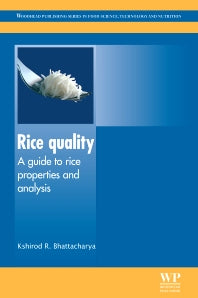Freshly Printed - allow 10 days lead
Couldn't load pickup availability
Rice Quality
A Guide to Rice Properties and Analysis
Kshirod R Bhattacharya (Author)
9781845694852, Elsevier Science
Hardback, published 27 June 2011
608 pages
23.3 x 15.6 x 3.4 cm, 1.06 kg
"This book is highly specific … the detail can’t be questioned, nor can the content. The index references are superb. A pleasure to read." --Food and Beverage Reporter "This book is an invaluable resource not only for professionals in the rice industry, but also warmly recommended as a guideline to researchers and post-graduate students in food sciences." --Advances in Food Sciences
Rice is a unique and highly significant crop, thought to help feed nearly half the planet on a daily basis. An understanding of its properties and their significance is essential for the provision of high quality products. This is all the more true today as international trade in rice trade has been increasing rapidly in recent years. This important book reviews variability in rice characteristics and their effects on rice quality.After an introduction on rice quality that also explores paradoxes associated with the crop, the book goes on to examine rice physical properties and milling quality. This leads to a discussion of the effects that the degree of milling has on rice quality. The ageing of rice and its cooking and eating quality are investigated in the following chapters before an analysis of the effect of parboiling on rice quality. Later chapters consider the product-making and nutritional quality of rice and investigate speciality rices and rice breeding for desirable quality. The book concludes with an extensive chapter on rice quality analysis and an appendix containing selected rice quality test procedures.With its distinguished author Rice quality: a guide to rice properties and analysis proves an invaluable resource for professionals in the rice industry and researchers and post-graduate students interested in rice.
Author contact details Woodhead Publishing Series in Food Science, Technology and Nutrition Preface Acknowledgements Dedication Chapter 1: An introduction to rice: its qualities and mysteries Abstract: 1.1 Rice in history 1.2 More rice paradoxes 1.3 Rice data and the tales they tell 1.4 Rice quality Chapter 2: Physical properties of rice Abstract: 2.1 Introduction 2.2 Grain appearance 2.3 Density and friction 2.4 Effect of moisture content 2.5 Miscellaneous properties 2.6 Chalky grains Chapter 3: Milling quality of rice Abstract: 3.1 Milling of rice 3.2 Grain cracking or fissuring at or around harvest 3.3 Drying of rice 3.4 Why the rice grain fissures 3.5 Miscellaneous factors that affect milling quality of rice 3.6 Fundamental cause of rice breakage: interrelationship and synergy between different factors Chapter 4: Degree of milling (DM) of rice and its effect Abstract: 4.1 Milling paddy grain and how much to mill 4.2 Effect of degree of milling (DM) on rice quality Chapter 5: Ageing of rice Abstract: 5.1 Introduction 5.2 Consumers’ perception of changes in rice behaviour during storage 5.3 Changes in physicochemical properties of rice during ageing as measured in the laboratory 5.4 Theories of rice ageing: relation to individual constituents 5.5 Some final rice paradoxes 5.6 Can the ageing process be hastened or retarded? Chapter 6: Cooking quality of rice Abstract: 6.1 Introduction 6.2 Absorption of water by rice during cooking at or near the boiling temperature 6.3 Hydration at lower temperatures 6.4 Loss of solids during cooking 6.5 Effect of presoaking in ambient water on cooking 6.6 Other changes/events occurring during cooking 6.7 Laboratory cooking of rice for various tests Chapter 7: Eating quality of rice Abstract: 7.1 Introduction 7.2 The initiation: the water-uptake paradigm 7.3 The period of data accumulation: the amylose paradigm 7.4 Exploration at the molecular level: the amylopectin paradigm 7.5 Rheology of rice-flour paste 7.6 Other factors that effect the eating quality of rice 7.7 Testing for rice quality Chapter 8: Effect of parboiling on rice quality Abstract: 8.1 Introduction: parboiled rice 8.2 Changes brought about in the rice grain and its constituents during the parboiling process 8.3 Properties of parboiled rice 8.4 Effect of rice variety on properties of parboiled rice 8.5 Products from parboiled rice Chapter 9: Product-making quality of rice Abstract: 9.1 Introduction 9.2 Table rice 9.3 Rice flour and products thereof 9.4 Rice breakfast cereals and snacks made from wholegrain rice 9.5 Other rice products Chapter 10: Speciality rices Abstract: 10.1 Introduction 10.2 Aromatic rices 10.3 Basmati 10.4 Jasmine 10.5 Other speciality rices Chapter 11: Nutritional quality of rice Abstract: 11.1 Introduction: why do we have to eat? 11.2 Nutritive value of rice is not a small matter 11.3 The perspective of nutrition of the poor rice-eater 11.4 Wholegrains versus refined grains: two views 11.5 No, wholegrains confer untold benefits 11.6 The perspective of the nutritive value of individual rice constituents 11.7 Biotechnological approach to upgrade the nutritive value of rice Chapter 12: Rice breeding for desirable quality Abstract: 12.1 Introduction 12.2 Plant characteristics for optimum harvest 12.3 Physical and morphological properties of the paddy grain that affect the quality of the final product 12.4 Susceptibility of the rice grain to cracking 12.5 End-use quality 12.6 Conclusions Chapter 13: Analysis of rice quality Appendix: some selected rice quality test procedures Index
Subject Areas: Agronomy & crop production [TVK], Food & beverage technology [TDCT]


